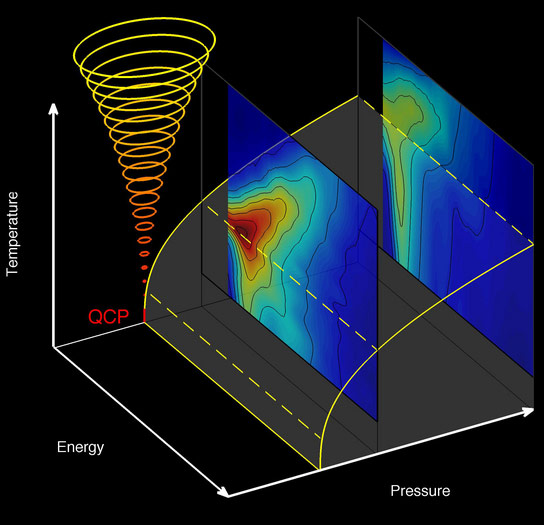
Phase diagram of the material TlCuCl3 at low temperatures. The quantum critical point (QCP) separates the phases without and with a magnetic order (at low and high pressures, respectively). Quantum fluctuations decrease with increasing pressure. The colors represent the neutron intensities measured and reflect the excitations in the material. Credit: Paul Scherrer Institute / Christian Rüegg
In a newly published study, researchers observe what happens during a quantum phase transition, and compare the “quantum melting” of the magnetic structure with the classical “thermal melting” phase transition.
When ice is warmed, the water molecules forming its structure vibrate more and more vigorously until finally the forces between them are no longer strong enough to hold them together – the ice melts and turns into liquid water. Quantum physics predicts that similar phenomena can be observed if the quantum mechanical fluctuations of the particles in a material can be altered. Such changes of state triggered by purely quantum effects – known as quantum phase transitions – play a role in many astonishing phenomena in solid-state systems, including high-temperature superconductivity. Researchers from Switzerland, Britain, France, and China have now specifically altered the magnetic structure of the material TlCuCl3 by exposing it to varying external pressure at different temperatures. By performing neutron-scattering measurements, they could observe what happens during a quantum phase transition, and compare the “quantum melting” of the magnetic structure with the classical “thermal melting” phase transition.
Whether water is liquid or solid, in the form of ice, depends on which of the two energies gains the upper hand. One is the bonding energy of the water molecules, and the other is the kinetic energy of molecular motion, which becomes increasingly vigorous the higher the temperature. If ice is heated above zero degrees Celsius, the movement of the molecules becomes so intense that the hydrogen bonds are no longer able to hold them together and the ice melts. The overall physical state is changed or, in physics terminology, a phase transition occurs. A similar phenomenon can be observed in magnets – if a magnet is heated, it becomes non-magnetic – and for a similar reason. We can imagine the magnet being made up of many tiny bar magnets, which physicists refer to as magnetic moments. If all these moments are aligned in parallel, the entire material is magnetically ordered and behaves like a magnet. If the material is heated, the direction of the moments fluctuates more and more strongly until the aligning forces are overcome and the magnetic order disappears: it has effectively melted.
Quantum-physical state
This “classic” melting is triggered by changes in temperature, but a comparable and equally fundamental phenomenon is determined by the laws of quantum physics. Quantum mechanics informs us that certain properties of particles in a material cannot be known exactly. This uncertainty is often referred to as quantum fluctuations: analogous to the classical fluctuations described above, the position of particles or the alignment of magnetic moments fluctuates over time. While the origin of the two kinds of fluctuations is completely different, in some situations they may have rather similar effects. A “melting” of the net ordered state of a system triggered by quantum fluctuations – a quantum phase transition – is the quantum-physical counterpart of the classical, thermal phase transition. Quantum-mechanical phase transitions are the key to many of the most exotic phenomena in solid-state physics, including high-temperature superconductivity.
The challenge of quantum fluctuations
Researchers from the Paul Scherrer Institute (Villigen, Switzerland) have now teamed up with colleagues from University College London, the Institut Laue-Langevin (Grenoble, France), and Renmin University (Beijing, China) to study the precise impact of quantum fluctuations and their interplay with classical fluctuations. The fundamental experimental challenge was to find a system allowing direct control of the quantum fluctuations, and for this they used the material TlCuCl3, which was produced at the University of Berne. Altering classical fluctuations is straightforward – the material can be heated and cooled. However, to control the quantum fluctuations in a magnetic material, the aligning forces between the moments have to be altered. The researchers exploited the fact that TlCuCl3 is relatively soft, so that the interatomic distances, and thus the interaction forces within the material, can be changed by applying an external pressure. In the experiment, they varied the pressure and the temperature over a broad range and studied the material using neutron sources at the PSI and the ILL. This enabled them to determine exactly how the state of the material changed through the quantum and classical phase transitions.
Disorder is not necessarily disorder
The researchers studied the arrangement of the magnetic moments. In TlCuCl3 the moments come in pairs, and at low pressures the magnetic forces between pairs are at their weakest, giving a state with no magnetic order. “However, this disordered state looks completely different from a classical disordered magnet, where the directions of the magnetic moments are simply random,” explains Christian Rüegg, a laboratory head at the Paul Scherrer Institute and supervisor of the research project. “Here, on the other hand, two neighboring moments form a magnetic pair, with the two moments pointing in exactly opposite directions. The interplay between neighboring pairs, however, is not strong enough, so no long-range order is formed.” In this case, the laws of quantum physics do not stipulate which of a pair’s moments points in which direction, and this complete uncertainty about the orientation of the individual moments corresponds to the strongest quantum fluctuations. If the pressure is now increased, the magnetic moments move together so that the moments from neighboring pairs feel each other more and more strongly until the paired state is replaced by a long-range magnetic order: a quantum phase transition comes about due to the pressure.
Quantum dynamics of the magnetic moments
In their experiment, the researchers focused primarily on the magnetic “excitations” inside the material, which provide extremely accurate information about the quantum states of the moments. These excitations can be imagined as a common, coordinated oscillation of the magnetic moments, much like a water wave or the vibration of a guitar string. The excitations are linked to magnetic “disorder” in the material as the more excitations there are, the more vigorously the magnetic moments fluctuate. Quantum physics dictates that most magnetic excitations in TlCuCl3 require a minimum energy to excite, and how easily these can be triggered depends on the interactions between the magnetic moments – controlled in this experiment by the temperature and by the pressure exerted on the sample. The researchers demonstrated that some excitations at both low and high pressures require rather high energy levels and are rarely occupied. However, if the pressure is adjusted towards the value where the quantum phase transition occurs, the minimum energy decreases and a number of different excitations can be observed. These also include one whose origin and mathematical description is exactly analogous to the Higgs boson in elementary particle physics, with the result that some researchers refer to the Higgs particle in solid materials. Rüegg explains: “We were absolutely astonished to find that these excitations played a key role, irrespective of whether the order was destroyed by quantum-mechanical or by classical fluctuations – a fascinating feature of quantum phase transitions.”
Neutrons reveal excitations
The researchers conducted neutron spectroscopy experiments using neutron sources at the Paul Scherrer Institute and the Institut Laue-Langevin. In their measurements, they passed a stream of neutrons through a sample of TlCuCl3 and observed how the flight path and speed of the neutrons changed. This enabled the team to study both the magnetic order and the excitations: if the neutron emerges moving more slowly than it entered, it must have lost its energy by triggering an excitation. “These fluctuations can only be observed with neutrons and it’s vital that you have the opportunity to study the sample at different pressure and temperature levels,” explains Martin Boehm, who supervised the measurements at the ILL. “In doing so, we benefit from one of the essential characteristics of neutrons: they can fly through the walls of the pressure cell where the sample is located practically unimpeded.”
Miracle material
“This type of spectroscopic experiment can be conducted for the first time with TlCuCl3 because the magnetic interactions are so sensitive to the applied pressure,” explains Rüegg. “In all the other materials we know you need a far greater pressure, which means you can only use very small samples – much too small for spectroscopic experiments with neutrons. Alternatively, you could try to produce many different samples that vary slightly in their structure but this would take a very long time and still would not yield a complete overview of the behavior.”
Reference: “Quantum and classical criticality in a dimerized quantum antiferromagnet” by P. Merchant, B. Normand, K. W. Krämer, M. Boehm, D. F. McMorrow and Ch. Rüegg, 6 April 2014, Nature Physics.
DOI: 10.1038/nphys2902

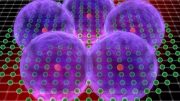
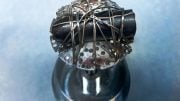
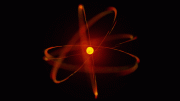
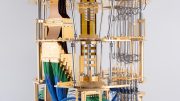
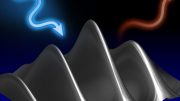


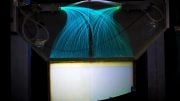
Citation: Whistler wave generated producing many singularities affect the ensuing dynamics of electrons and lattice atoms in the material helicon mode the mode structure rotates in+phi direction and-phi directions “Evidence for topological defects in a photo induced phase transition”
Peter Baum, a professor of physics at the University of Konstanz in Germany, who was not connected to this research, says “This is great work. One awesome aspect is that three almost entirely different, complicated methodologies have been combined to solve a critical question in ultrafast physics, by looking from multiple perspectives.”
A team of researchers has observed that when they trigger a phase change by using intense pulses of laser light, instead of by changing the temperature, the process occurs very differently. The researchers found that during the optically induced melting, the phase change proceeds by generating many singularities in the material, known as topological defects, and these in turn affect the ensuing dynamics of electrons and lattice atoms in the material. a fast phase transition is quenching — such as suddenly plunging a piece of semimolten red-hot iron into water to cool it off almost instantly. While these optically induced phase changes have been observed before, the exact mechanism through which they proceed was not known The smaller white spots close on either side of the central dot show the charge density wave, by the pi phase shifting in between +phi and-pi which is analogous to a crystal structure, as it “melts” when hit with an ultrafast laser pulse, and then “refreezes.” The rotation of a phase contour, enhanced by a white line, rotates clockwise with increasing time the wave rotation may be positive of negative depending on the phasing Strong helicon whisler waves may trap light electrons but this has not yet been observed.
The rotation of a phase contour, enhanced by a white line, rotates clockwise with increasing time the wave rotation may be positive of negative depending on the phasing Strong helicon whisler waves may trap light electrons but this has not yet been observed. The wave is excited by a phased antenna array located on the black circle. The propagating field is displayed at an instant of time by contours of the axial field component and vector fields for the transverse wave field. The phase of the wave rotates clockwise with increasing time, indicating here a helicon with mode number m = –4. The field vectors rotate counter clockwise as seen in the enlarged pictures on the top. This identifies the wave as a whistler mode whose field polarization is always right-hand circular with respect to the axial field B0 with redpect to constant Bz mode) a helicon mode It has three pairs of positive and negative peaks, which forms an m = 3 helicon mode. In time the mode structure rotates in+phi direction and-phi directions.
The team used a combination of three techniques, known as ultrafast electron diffraction, transient reflectivity, and time- and angle-resolved photoemission spectroscopy, to simultaneously observe the response to the laser pulse.
For their study, they used a compound of lanthanum and tellurium, LaTe3, which is known to host charge density waves. Together, these instruments make it possible to track the motions ofatoms within the material as they change and respond to the laser pulse. The team used a combination of three techniques, known as ultrafast electron diffraction, transient reflectivity, and time- and angle-resolved photoemission spectroscopy, to simultaneously observe the response to the laser pulse the magnetic moments move together so that the moments from neighboring pairs feel each other more and more strongly until the paired state is replaced by a long-range magnetic order: a quantum phase transition comes about
Researchers from Switzerland, Britain, France and China have now specifically altered the magnetic structure of the material TlCuCl3 by exposing it to a varying external pressure at different temperatures. By performing neutron-scattering measurements, they could observe what happens during a quantum phase transition, and compare the “quantum melting” of the magnetic structure with the classical “thermal melting” phase transition.
This information may be used to control Halls thrust disturbing the typical error in mobiles for a perfect row or column punching
Sankaravelayudhan Nandakumar
While these optically induced phase changes have been observed before, the exact mechanism through which they proceed was not known. . .
A team of researchers has observed that when they trigger a phase change by using intense pulses of laser light, how does this fit an integument for electrons? Where is the integument for an electron on its wavepath?
The Sun in 4K: THERMONUCLEAR ART RELAXATION + Connect.Ohm [9980] | NASA Video
The rotation of a phase contour, rotates clockwise with increasing time on the wave rotation may be positive/negative in di-synchrony depending on the phasing from torsion into the electron’s path the wavepath.
The propagating field is displayed at an instant of time by contours of the axial field component and vector fields for the transverse wave field.
The phase wave in its plane p/n di-synchrony rotates clockwise with increasing time of a phase contour indice. . .
Spin–orbit-torque magnonics
Google Images
nelson symplectic topologies
electron quantum phase contour indice
Postdocs in Complexity Conference VIII
Can We Break the Landauer Bound in Spin-Based Electronics?